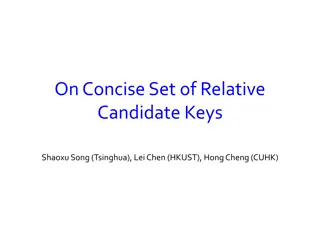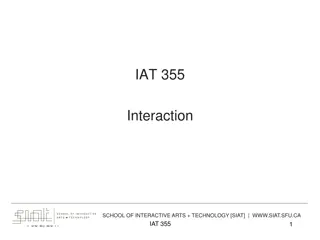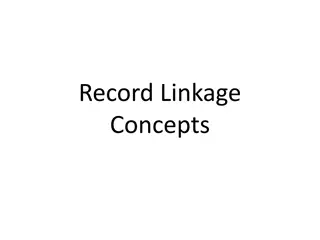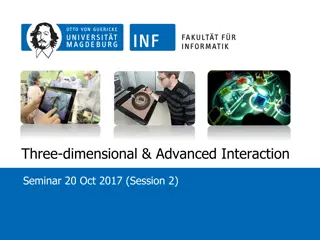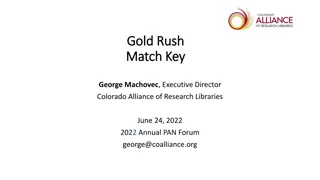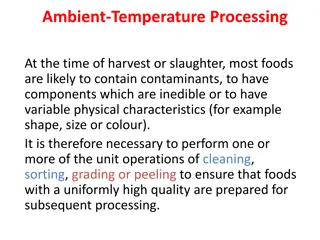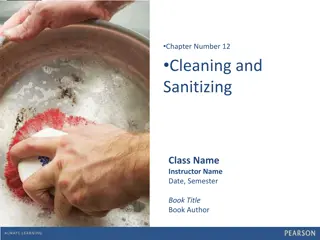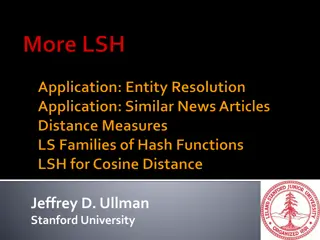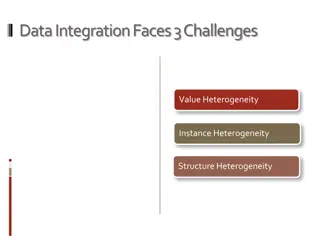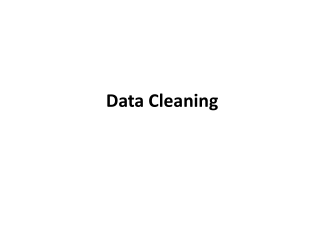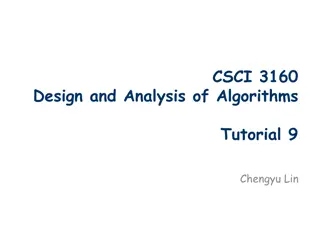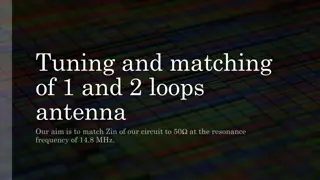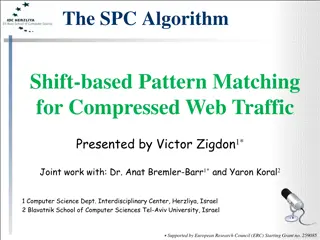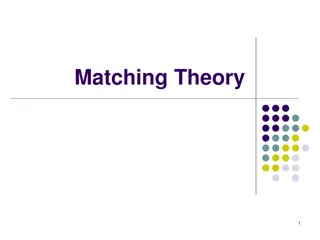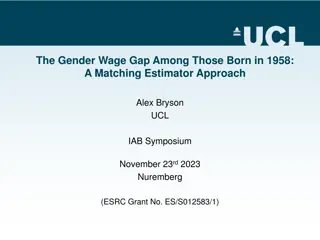The Interaction Between Record Matching and Data Repairing in Data Cleaning Systems
Explore the connection between record matching and data repairing in data cleaning processes, highlighting the significance of addressing dirty data in businesses. Discuss a motivating example and goals to propose a unified framework for data cleaning that emphasizes accuracy and scalability through experimental evaluation.
Download Presentation

Please find below an Image/Link to download the presentation.
The content on the website is provided AS IS for your information and personal use only. It may not be sold, licensed, or shared on other websites without obtaining consent from the author. Download presentation by click this link. If you encounter any issues during the download, it is possible that the publisher has removed the file from their server.
E N D
Presentation Transcript
The Interaction Between Record Matching and Data Repairing Authors: Wenfei Fan Jianzhong Li Shuai Ma Nan Tang Wenyuan Yu Presenter: Omeed Habibelahian
Background Dirty data costs US businesses $600 billion each year The market for data cleaning systems is growing 17% annually Central pieces of data cleaning: Record matching Data repairing Many data cleaning systems support both Both processes often interact with each other Nonetheless treated as separate and independent processes
Motivating Example CFDs (?) and MD ( ): ?1: tran([AC = 131] [city = Edi ]) ?2: tran([AC = 020] [city = Ldn ]) ?3: tran([city, phn] [St, AC, post]) ?4: tran([FN = Bob ] [FN = Robert ]) : tran[LN, city, St, post] = card[LN, city, St, zip] tran[FN] card[FN] tran[FN, phn] is changed to card[FN, tel] Relations: card(FN, LN, St, city, AC, zip, tel, dob, gd) tran(FN, LN, St, city, AC, post, phn, gd, item, when, where)
Motivating Example s1= card(FN = Mark , LN = Smith , St = 10 Oak St , city = Edi , AC = 131, zip = EH8 9LE , tel = 3256778, dob = 10/10/1987, gd = Male ) s2= card(FN = Robert , LN = Brady , St = 5 Wren St , city = Ldn , AC = 020, zip = WC1H 9SE , tel = 3887644, dob = 12/08/1975, gd = Male ) FN LN St city AC post phn gd item when where t1 M. Smith 10 Oak St Ldn 131 EH8 9LE 9999999 Male watch 11am 28/08/10 UK t2 Max Smith Po Box 25 Edi 131 EH8 9AB 3256778 Male DVD 8pm 28/09/10 IND t3 Bob Brady 5 Wren St Edi 020 WC1H 9SE 3887834 Male iPhone 6pm 06/11/09 UK t4 Robert Brady null Ldn 020 WC1E 7HX 3887644 Male necklace 1pm 06/11/09 US Bank suspects that both tuples are the same person potential fraud Get a repair t3 of t3with t1 [city] = Ldn (?2) and t3 [FN] = Robert (?4) Match t3 to s2of Dm, to which can be applied Get a repair t3 of t3 with t3 [phn] = s2[tel] Get a repair t4 of t4 ?3since t3 and t4 agree on city and phn Fill t4 [St] and fix t4 [post] by taking those correct values from t3
Goals and Contributions Goals: Contributions: Investigate a new problem: data cleaning problem Propose uniform framework for data cleaning Investigate fundamental problems associated with data cleaning via matching and repairing Propose three-phase solution to solve the complexity brought on by these problems Experimentally evaluate the quality and scalability of their proposed solutions Unify record matching and data repairing Propose a data cleaning solution that stresses accuracy
Data Cleaning Problem Given a database D, master data Dm, and data quality rules consisting of CFDs and matching rules : Goal: to find a repair Drof D such that: Drsatisfies the CFDs No more tuples in Drcan be matched to master tuples in Dmby rules of Drminimally differs from D Fix by unifying matching and repairing, and by leveraging master data Use matching rules that are extensions of MDs by supporting neg. rules E.g. a male and female may not refer to the same person
Positive MDs For a tuple t in D and a tuple s in Dm, if for each j [1,k], t[Aj] and s[Bj] are similar, then for each i [1, h], t[Ei] is changed to s[Fi] (clean master data) : tran[LN, city, St, post] = card[LN, city, St, zip] tran[FN] card[FN] tran[FN, phn] matches with card[FN, tel] Instance D1of tran with tuple t1 with t1 [city] = Ldn , all other A, t1 [A] = t1[A] (D1, Dm) does not satisfy , since t1 [FN, phn] does not match with s1[FN, tel] Correct t1 [FN, phn] with s1[FN, tel]
Negative MDs For any tuple t in D and any tuple s in Dm, if t[Aj] s[Bj] for some j [1,k], then t and s may not be a match 1: tran[gd] card[gd] there is some i [1,7] such that tran[Ai] does not match card[Bi] (Ai, Bi) ranges over (FN, FN), (LN, LN), (St, St), (AC, AC), (city, city), (post, zip), and (phn, tel) Says that a male and a female may not refer to the same person
Normalized CFDs and MDs Normalized CFDs and MDs A CFD or MD is called normalized if the RHS of the dependency has a length of 1, CFD: RHS consists of a single attribute MD: RHS consists of a single attribute pair ?1, ?2, and ?4are normalized
UniClean Input: Dirty relation D Master relation Dm Set of cleaning rules derived from = , where is a set of CFDs on R, and is a set of MDs on (R, Rm) Thresholds , [0, 1] set by the user for confidence and entropy Output: Repair Drof D with a small cost such that Drsatisfies and (Dr, Dm) satisfies Generates fixes by unifying matching and repairing, via cleaning rules Distinguishes these fixes with three levels of accuracy cost(Dr, D) =
Confidence and Cost The higher the confidence of the attribute t[A] is, the more distant v is from v, the more costly the change is Smaller cost means that Dris more accurate and closer to D dis(v, v )/max(|v|, |v |) is used to measure similarity to ensure that longer strings with a 1-char difference are closer than shorter strings with a 1- char difference
Cleaning Rules Tell us what attributes should be updated and what they should be changed to, and enable us to interleave matching and repairing operations MDs: Given MD ? = j [1,k](R[Aj] jRm[Bj]) (R[E] matches with Rm[F]) Apply a master tuple s Dmto a tuple t D if t[Aj] js[Bj] for each j [1,k] Update on t: t[E] = s[F] t[C].cf = d for each C in E, where d is the minimum t[Aj].cf for all j [1,k] if jis = This cleaning rule applies to both positive and negative MDs
Cleaning Rules Constant CFDs: Consider a CFD ?c= R(X A, tp1), where tp1[A] is a constant Rule applies to t if t[X] matches tp1[X] but t[A] tp1[A] Update on t: t[A] = tp1[A] t[A].cf = d, where d is the minimum t[A ].cf for all A in X The rule corrects t[A] with constant in the CFD
Cleaning Rules Variable CFDs: Consider a CFD ?v= R(Y B, tp2), where tp2[B] is a wildcard _ Apply a tuple t2in D to another tuple t1in D, where t1[Y] = t2[Y] tp2[Y] but t1[B] t2[B] Update on t: t1[B] = t2[B] t1[B].cf = d, where d is the minimum t1[B ].cf and t2[B ].cd for all B in Y
Problems for Data Quality Rules Consistency problem: Whether there exists a nonempty instance D of R such that D satisfies and (D, Dm) satisfies Determines whether the rules in = are dirty For CFDs and MDs put together, NP-complete Implication problem: Determine, given Dm, and another CFD or MD , whether satisfies Helps us find and remove redundant rules from to remove performance I.e. rules that are logical consequences of other rules implies another CFD or MD if for any instance D of R, whenever D satisfies and (D, Dm) satisfies , then D ( or (D, Dm)) satisfies coNP-complete
Problems for Data Quality Rules Complexity bounds in the data cleaning problem: Intractable to decide if there exists Drwith cost(Dr, D) below a predefined bound Infeasible in practice to find a p-time approx. algorithm with performance guarantee DCP is NP-complete Unless P = NP, for any constant , there is no p-time -approximation algorithm for DCP Termination problem: determine whether a rule-based process stops Determinism problem: asks whether all terminating cleaning processes end with the same repair E.g. ?1= tran([AC] [city], tp1= (131 Edi)), ?5= tran([post] [city], tp5= (EH8 9AB Ldn)) Instance D1containing tuple t2from earlier t2: ( Max , Smith , Po Box 25 , Edi , 131, EH8 9AB , 3256778 Male , DVD, 800 INR , 8pm 28/09/2010 , India) Repair process with ?1and ?5will fail to terminate Beyond reach to find efficient solutions for either problem
Important Notation = : a set of CFDs and a set of MDs = confidence threshold 1= update threshold 2= entropy threshold = selection = projection ( ) = the set (t | t is in D and t[Y] = ) for each in Y( Y matches tp[Y]D) w.r.t. CFD (Y B, tp)
Deterministic Fixes Based on Confidences Identifies erroneous attributes t[A] to which there exists a unique fix, called a deterministic fix, when some attributes of t are accurate Fixes based on confidence Cleaning rule: Update t[A] only if certain attributes of t have confidence above the threshold These fixes are accurate up to
Deterministic Fixes on MDs Given MD ? = j [1,k](R[Aj] jRm[Bj]) (R[E] matches with Rm[F]) Suppose a cleaning rule ? applies a tuple s in Dmto a tuple t in D and generates a fix t[E] := s[F] The fix is deterministic if: t[Aj].cf >= for all j [1,k] t[E].cf < t[E] := s[F] only if all t[Aj] s are asserted and t[E] is not yet asserted
Deterministic Fixes on Constant CFDs Given constant CFD ?c= R(X A, tp1) Suppose ? applies to a tuple t in D and changes t[A] to tp1[A] in ?c The fix is deterministic if: t[Ai].cf >= for all Ai X t[A].cf <
Deterministic Fixes on Variable CFDs Given constant CFD ?v= (Y B, tp) For each in ?Y( Y matches tp[Y]D), ( ) = {t | t D, t[Y] = } Suppose ? applies a tuple t2in ( ) to another t1in ( ) for some , and changes t1[B] to t2[B] The fix is deterministic if: For all Biin Y, t1[Bi].cf >= and t2[Bi].cf >= t2is the only tuple in ( ) with t2[B].cf >= Which means t1[B].cf <
Deterministic Fix Algorithm: cRepair Update: Given a new deterministic fix for t[A], propagate the change to find other deterministic fixes with t[A] For each variable CFD , if A is in LHS( ), count[t, ] is incremented If all attributes in LHS( ) are asserted, insert into the queue For a variable CFD in P[t], if RHS( ) is A and the hash value of is nil, t[A] makes it possible for tuples in the list to have a deterministic fix, so move from P[t] to the queue
Deterministic Fix Algorithm: cRepair vCFDInfer: Find a deterministic fix for t by applying if it exists If t and the pattern tuple t(p, )match on their LHS( ) attributes: If t[RHS( )] >= and no B-attr in the hash list of is asserted, take t[RHS( )] as the B-value in the set and updates If t[RHS( )] < but there is an asserted B-attr val in the hash list, do deterministic fix t[RHS( )] = val and update If t[RHS( )] < and no asserted B-attr val in hash list, no deterministic fix; add t to hash list and P[t] for later checking cCFDInfer and MDInfer Find deterministic fixes by applying the rules derived from Propagate changes by invoking update(t, RHS( ))
cRepair: Example Consider Dmand D from the beginning consists of rules 1, 2, and 3based on ?1, ?3, and = 0.8 Find deterministic fixes for t1and t2w.r.t. After lines 1-6: H 2= Q[t1] = { 1} Q[t2] = { 2} P[t1] = P[t2] = count[t1, 1] = 1, count[t1, 2] = 0, count[t1, 3] = 3, count[t2, 1] = 0, count[t2, 2] = 0, count[t2, 3] = 2 After 2in Q[t2] is checked: Q[t2] = P[t2] = 2 H 2(t2[city, phn]) = ({t2}, nil)
cRepair: Example After 1in Q[t1] is applied: Q[t1] = { 3} count[t1, 2] = 1 count[t1, 3] = 4 t1[city] := Edi t1[city].cf = 0.8 When 3in Q[t1] is used: t1[phn] := s1[tel] t1[phn].cf = 0.8 Q[t1] = 2 count[t1, 2] = 2 When 2in Q[t1] is used: t2[St] = t1[St] = 10 Oak St t2[St].cf = 0.8 Q[t1] = P[t2] = Terminates since Q[t1] and Q[t2] are both empty
Reliable Fixes Based on Entropy For attributes with low or unavailable confidence, we correct them based on the relative certainty of the data, measured by entropy Cleaning rule : Update t[A] only if the entropy of for certain attributes of t is below the threshold Fixed based on entropy are accurate to a certain degree and marked as reliable fixes
Reliable Fix Algorithm: eRepair Sort cleaning rules based on dependency graph G = (V, E) Each rule of is a node in V Edge from 1to 2if 2can applied after the application 1 Edge (u, v) means u should be applied before v Find SCCs in G, convert G to DAG Find topological order on nodes Sort SCC on ratio of out-degree to in-degree, in decreasing order Higher ratio = more effect on other nodes
Dependency Graph Example This graph G is an SCC Ratios of out-degree to in-degree are: ?1: 2/1 ?2: 2/1 ?3: 1/1 ?4: 3/3 : 2/4 Therefore, order O is ?1> ?2> ?3> ?4> Nodes with the same ratio are sorted randomly
Reliable Fix Algorithm: eRepair vCFDResolve: Applies cleaning rule derived from a variable CFD = R(Y B, tp) For each set ( ) with in Y( Y tp[Y]D), if the entropy of for Y = < the entropy threshold 2, pick the value b B( ( )) that has max. cntY B( , b) For each tuple t in ( ), if t[B] has been changed less than 1times, t[B] := b
Reliable Fix Algorithm: eRepair cCFDResolve: Applies cleaning rule derived from CFD = R(X A, tp1) For each tuple t in D, if t[X] tp1[X], if t[A] tp1[A], and if t[A] has been changed less than 1times, then update t[A] to tp1[A]
Reliable Fix Algorithm: eRepair MDResolve: Applies cleaning rule derived from MD = j [1,k](R[Aj] jRm[Bj]) (R[E] matches with Rm[F]) For each tuple t in D, if there exists some s in Dmsuch that t[Aj] js[Bj] for j [1, k], t[E] s[F], and t[E] has been changed less than 1times t[E] := s[F] Fixes by cRepair not affected
eRepair: Example Instance of schema R(ABCEFH) shown here CFD = R(ABC E, tp1); tp1only wildcards is an FD H( | ABC = (a1, b1, c1)) 0.8 H( | ABC = (a2, b2c2)) = 1 H( | ABC = (a2, b2, c3)) = 0 H( | ABC = (a2, b2, c4)) = 0 (ABC = (a2, b2, c3)) and (ABC = (a2, b2, c4)) do not violate Fix based on H( | ABC = (a1, b1, c1)) is fairly accurate, but not H( | ABC = (a2, b2c2)) eRepair changes t4[E] to e1, marks as reliable
Possible Fixes For errors that have not yet been fixed Use heuristic methods to generate fixes, called possible fixes The heuristic method always finds a repair Drof D such that Drsatisfies and (Dr, Dm) satisfies Does not touch deterministic fixes produced earlier After this whole process, fixes are marked with distinct signs to indicate deterministic, reliable, and possible fixes
Experimental Study Two real-world data sets: HOSP data from US Dept of HHS 100k records with 19 attributes DBLP data from DBLP Bibliography 400k tuples, each with 12 attributes Master data carefully selected from same sources for correctness and consistency w.r.t. the designed rules Dirty datasets produced by introducing noise, controlled by 4 parameters: |D|: data size noi%: noise rate ratio of # erroneous attrs to total attrs in D dup%: duplicate rate % of tuples in D that can find a match in Dm asr%: asserted rate default value = 40%
Experimental Study Algorithms All algorithms implemented in Python cRepair, eRepair, hRepair in UniClean hRepair is the heuristic-based algorithm for possible fixes in UniClean SortN: sorted neighborhood method; for record matching based on MDs only quaid: heuristic repairing algorithm; based on CFDs only Uni refers to cleaning based on both CFDs and MDs Uni(CFD) denotes cleaning using CFDs (repairing) only Edit distance used for similarity test
Experimental Study Metrics: precision, recall, F-measure Precision: ratio of true matches correctly found to all duplicates found Recall: ratio of true matches correctly found to all matches between a dataset and master data F-measure = 2 * (precision * recall) / (precision + recall) In all experiments, = 1.0, = 0.8; dirty and master data have 60k tuples
Exp-1: Matching Helps Repairing dup% set to 40% (CFDs only) Uni outperforms Uni(CFD) and quaid by up to 15% and 30% Uni is less sensitive to noi% Uni(CFD) also outperforms quaid
Exp-2: Repairing Helps Matching Same settings and dup% as Exp-1 Uni outperforms SortN by up to 15% Uni is less sensitive to noi% Repairing does indeed help with matching
Exp-3: Accuracy of Det. and Reliable Fixes Same dup% as Exp-1 and Exp-2 Deterministic fixes have the highest precision but have low recall Fixes by Uni have the lowest precision but the highest recall
Exp-4: Impact of dup% and asr% on Det. Fixes (i): asr% set to 40%, (j): dup% set to 40% The larger dup% is, the more deterministic fixes are found The number of deterministic fixes found by cRepair highly depends on asr% Cleaning rules are only applied to asserted attributes to find these fixes
Exp-5: Scalability noi% set to 6%, dup% set to 40% Uni scales reasonably well with both, and does so much better than quaid quaid took >10 hours to scale with |D| = 80k; Uni took about 11 min Verify effectiveness of indexing structures and optimization techniques developed for Uni



